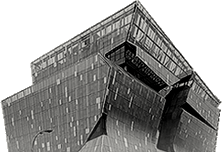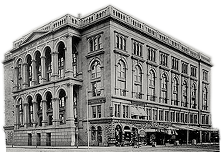Education of an Architect
 .
. 
THESIS 2023
Edited by Sarah A. Bojsen, Yunru Daisy Chen, Earl Kwofie, Kyungmin Park, Frderick (Didi) Rapp, Andrew Song, Raymond Tan, Steven Hillyer, and Chris Dierks.
A thesis never exists in isolation—it is influenced by the world in which it was synthesized. Our class has traveled through time and space, tackling subjects ranging from the extra-personal to proposals at the scale of countries. The thread tying these diverse projects together is the discipline of architecture. As we move on from Cooper, our class is beginning to understand that the discipline as we know it is becoming less about the form and appeal of work by previous generations, and more about the political, environmental, and social impact that our work entails. Through thesis, we hope to find ways to create a new status quo for what architecture can be, while spotlighting how great it has been. Our labor is the beating heart of evolution, driving the discipline to new frontiers and confronting the inherent biases architecture can encompass.
— Sarah A. Bojsen & Earl Kwofie
With texts by Nora Akawi, Hayley Eber, Lydia Kallipoliti, Maren Speyer, and Michael Young.
NY: THE IRWIN S. CHANIN SCHOOL OF ARCHITECTURE, 2024
191 PAGES. 8 ¾ x 12 ½
SOFTCOVER, $20.00
Purchase

ARCHITECTS DRAW
Sue Ferguson Gussow
Architects Draw, by Professor Emerita Sue Ferguson Gussow, chronicles the unique pedagogy of freehand drawing that Gussow developed over the course of several decades at The Cooper Union—a pedagogy that has shaped how aspiring architects explore the possibilities of architecture through drawing. Originally released by Princeton Architectural Press in 2008, the book was reprinted in 2023 by the architectural publisher B, with The Irwin S. Chanin School of Architecture as co-publisher. The revised edition includes new student and professional work in the chapters “Dirty Drawing” and “Drawing in Practice,” respectively.
Architects Draw documents more than twenty exercises that train the architect’s eye, hand, and mind using diverse, unexpected subjects—bell peppers and seashells as housing; paper bags to reveal architectural planes; shoes to define volume and void; frames and windows to consider problems of measurement and scale; and trees to explore gesture and the interpenetration of form and space. The book is illustrated with more than two hundred student drawings and examples from the architecture and design practices of Cooper alumni.
Since its original publication, Architects Draw has been invaluable to numerous architecture professors at schools both domestic and international, who have used Gussow’s drawing prompts in their own teaching. The updated reprint of this critically important publication will support its ongoing educational influence.
With texts by Dore Ashton, Hayley Eber, and Anne Romme.
COPENHAGEN: B | NY: THE IRWIN S. CHANIN SCHOOL OF ARCHITECTURE, 2023
208 PAGES. 6 ¾ x 9 ½
SOFTCOVER, $30.00
Purchase

COASTAL URBANISM AND THE GEOPHYSICAL CITY
Fall 2021 Design IV Studio | Susannah Drake, Nadège Giraudet
Coastal Urbanism and the Geophysical City was the title of a studio led by Susannah Drake and Nadège Giraudet in the fall of 2021 at The Irwin Chanin School of Architecture.
The studio explored the necessity for a radical rethinking of the role of landscape ecology and infrastructure within the city. Its research laboratory was the Gowanus Canal in Brooklyn, a former tidal estuary-turned-superfund site that is undergoing rapid development, and experiences regular fl ooding and sea level rise. The area is a microcosm of the many forces at play in today’s urban environments, be they economic, geophysical, biological, ecological, historical, industrial, or political. Students were encouraged to engage with all of these layers and imagine a possible future in the wake of the increasing threat of climate change to coastal cities.
With texts by Joseph Alexiou, Sagi Golan, Elizabeth Hénaff, Andrea Parker, and Dan Wiley.
NY: THE IRWIN S. CHANIN SCHOOL OF ARCHITECTURE, 2023
92 PAGES. 12 x 7 ¾
SOFTCOVER, $20.00
Purchase


THESIS 2021
Edited by Javier Blancas, Zhenia Dementyeva, Maksymilian Mamak, Gabriella Orsi, Steven Hillyer, and Chris Dierks.
Thesis at The Cooper Union is an opportunity for architectural discourse and speculation, for discovery and experimentation, for analysis and re-examination. Though often motivated by personal interests, a Thesis project is always shaped both by its temporal context and an exchange of media, questions, and provocations.
The projects that emerged from this immersive and rich environment have launched a journey riddled with complexity, struggle, and perseverance—one that already feels perilous and daunting under normal circumstances. Yet the Class of 2021’s journey was anything but normal. As a worldwide pandemic—unprecedented in over a century—enters its third year, the trajectories of our politics, public health, environment, and economy remain uncertain.
Reflecting on this extraordinary change in all of our lives and the sacrifices that have gone unnoticed for far too long has opened a window for hard and honest introspection. As we saw early in the lockdown, issues of race, identity, politics, culture, and everything in-between were unleashed in the public sphere, reaching a climax in the summer of 2020 and striking us all with a new energy. But even as these factors merged with the ever-present reality of physical isolation, our interests, passions, and hobbies seemed to bring us into closer conversations than ever before. The twenty-six projects featured in this publication can be understood as self-portraits—reflections of our dreams and aspirations manifest through varied and unique conventions of the discipline.
—The Editors (Javier, Zhenia, Maks, Gabriella)
With texts by Nader Tehrani, Hayley Eber, Nora Akawi, Lauren Kogod, Stephen Rustow, and Michael Young.
NY: THE IRWIN S. CHANIN SCHOOL OF ARCHITECTURE, 2022
137 PAGES. 8 ¾ x 12 ½
SOFTCOVER, $20.00
Purchase


THESIS 2020
Edited by Kayla Montes de Oca, Helmuth Rosales, Cheung Lun (Jeremy) Son, Steven Hillyer, and Chris Dierks.
As the seventh consecutive class to publish their undergraduate Thesis work, the graduates of 2019-2020 did so under unprecedented circumstances: midway through the academic year, the COVID-19 pandemic upended their studio and their studies. This publication underscores their determination, creativity and collaborative spirit, not to mention the remarkable work they produced—both individually and as a class. As noted by the student editors:
The projects in this book belong to us: fifteen students who retreated to our homes across the city, country, and world to fulfill the contract of completing our theses despite the circumstances. There was no time to reorient and steer our projects into the crisis; the challenge was instead to continue our work and fulfill our role as Thesis students, allowing each of our projects to follow its own ambition and scope. In the meantime, our new desks sat in an empty studio, cluttered with undocumented models in progress, printed drawings awaiting critique, lamps still plugged in. We each found ourselves in our Thesis and out of the school, half-in and half-out.
With texts by Dean Nader Tehrani, Associate Dean Hayley Eber, and Assistant Professor Nora Akawi.
NY: THE IRWIN S. CHANIN SCHOOL OF ARCHITECTURE, 2021
139 PAGES. 8 ¾ x 12 ½
SOFTCOVER, $20.00
Purchase
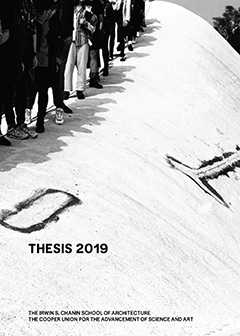
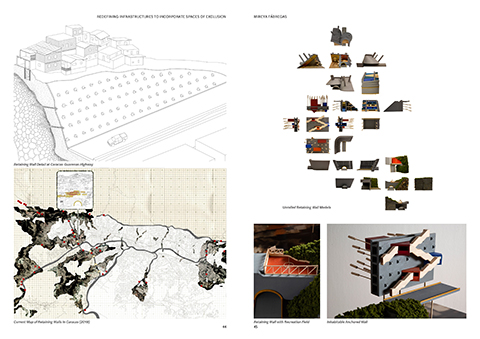
THESIS 2019
Edited by Natalia Oliveri, Cyrus Henry, Steven Hillyer, and Chris Dierks.
Part of an ongoing series, this publication features the undergraduate Thesis work of the 2018-2019 class. Produced annually since 2014, the Thesis publication is designed and edited by graduating students under the direction of their Thesis faculty and the Architecture Archive. In their introductory essay, the student editors frame the Thesis within the context of their time at Cooper Union, setting the stage for the remarkable work generated by their class:
The construction of a Thesis is an act of identification, one that comes to define each individual within a class, eventually revealing how the studio as a whole operates when theses are placed adjacent to one another. In retrospect, each class provides a gestural stroke contributing to the larger landscape that is the School of Architecture. While this collective identity is of great importance as it continues to accumulate and shift, the tradition of publishing the work of the graduating class allows us to examine the nuances and details of each Thesis…Each Thesis takes a deep dive into its investigation, and collectively they cover a broad cultural spectrum. Thesis is an act of asking questions, exploring the unknown, and developing the confidence to assert a position within the field of architecture as it continues to reckon with its implications for, and traction on, our larger socio-political world.
With texts by Dean Nader Tehrani and faculty members Cristina Goberna Pesudo and Farzin Lotfi-Jam.
NY: THE IRWIN S. CHANIN SCHOOL OF ARCHITECTURE, 2021
119 PAGES. 8 ¾ x 12 ½
SOFTCOVER, $20.00
Purchase


ARCHITECTURE OF NATURE/NATURE OF ARCHITECTURE
Diana Agrest
This publication presents original research exploring the materiality and the forces at play in the history of the earth. While nature has always been historically embedded “within” architecture discourse in different forms, Architecture of Nature/Nature of Architecture departs from the traditional ‘nature as a referent’ approach, detaching itself as a free radical to become the object of study, transforming that relationship through one common element essential to both science and architecture in the production of knowledge: representation. This work was developed through unique drawings and models over eight years in the context of the Advanced Research Graduate Design Studio created and directed by Diana Agrest at The Irwin S. Chanin School of Architecture of The Cooper Union. Building on scientific material, the complex processes of generation and the transformations of extreme natural phenomena—such as glaciers, volcanoes, permafrost, clouds, coral reefs, and algae—are explored, introducing a different dimension of space, time, and scale that transcend the established disciplinary boundaries of architecture, urbanism, and landscape.
With essays by Diana Agrest, Peter Louis Galison, Caroline A. Jones, D. Graham Burnett, and John McPhee.
CA: ORO EDITIONS, APPLIED RESEARCH + DESIGN PUBLISHING, 2018
280 PAGES, 9 x 11 ¾
HARDCOVER, $50.00
Purchase


THESIS 2018
Edited by Leslie Dougrou, Liaoran Zhang, and Steven Hillyer.
This publication—the fifth in an ongoing, annual series documenting undergraduate Thesis projects—presents a broad range of compelling student work organized according to four general themes: Urban Narrative, Representation & Perception, Framework, and Memory & Metaphor. As noted by Dean Tehrani, this work demonstrates “a depth of research that is able to penetrate areas of urbanism, technology, representation, the body, utopias and dystopias, among a range of other themes…This year’s Thesis thrived in the uncertainties of this environment, catapulted by both history and the present, in search of possible futures; through it, we came to a certain recognition of the humility of a pedagogical process negotiating with the myth of freedom, the inevitable loss of control, and the imperative to build a Thesis.”
With texts by Dean Nader Tehrani and faculty members Eva Franch I Gilabert, Igor Bragado, and Anthony Vidler.
NY: THE IRWIN S. CHANIN SCHOOL OF ARCHITECTURE, 2022
113 PAGES. 8 ¾ x 12 ½
SOFTCOVER, $20.00
Purchase


THESIS 2017
Edited by Daniel Hall, Jenny Hsaio, Sam Koopman, Hui Rong Liu, Piao Liu, Steven Hillyer, and Lauren Kogod.
This is the fourth in the annual series of thesis publications chronicling undergraduate Thesis work. The 2016-17 Thesis studio fostered group discourse exploring ideas of the relationship between words (intentions, theories, questions, aspirations-the thesis) and form (shape, material, representation, place scale, program-the project). The projects that were developed questioned the necessity of scale, site, program, form, embodiment and materiality.
With texts by Lauren Kogod, David Turnbull, Nader Tehrani, and Maya Krtic, and a collection of memories honoring Professor Diane Lewis by Daniel Meridor.
NY: THE IRWIN S. CHANIN SCHOOL OF ARCHITECTURE, 2018
72 PAGES, 8 ¾ x 12 ½
SOFTCOVER, $20.00
Purchase


THESIS 2016
Edited by Sam Choi, Alice Colverd, Cassandra Engstrom, Diego González, Thomas Heyer, Jonathan Ngo, Vanessa Tai, and Janine Wang.
This publication highlights undergraduate Thesis projects completed in the 2014-15 academic year. Inspired by the Yves Klein work A Leap Into the Void, the studio was prompted to consider "the inclination toward "the abyss," toward the unknown…the magnet activating intellectual curiosity in the arts and sciences…To reach this place, one must leap into the void: an unsighted, often reckless and always erratic exploration of the uncharted territories where architectural research dwells."
With texts by Hayley Eber, Pep Avilés, and Lauren Kogod.
NY: THE IRWIN S. CHANIN SCHOOL OF ARCHITECTURE, 2016
72 PAGES, 8 ¾ x 12 ½
SOFTCOVER, $20.00
Purchase
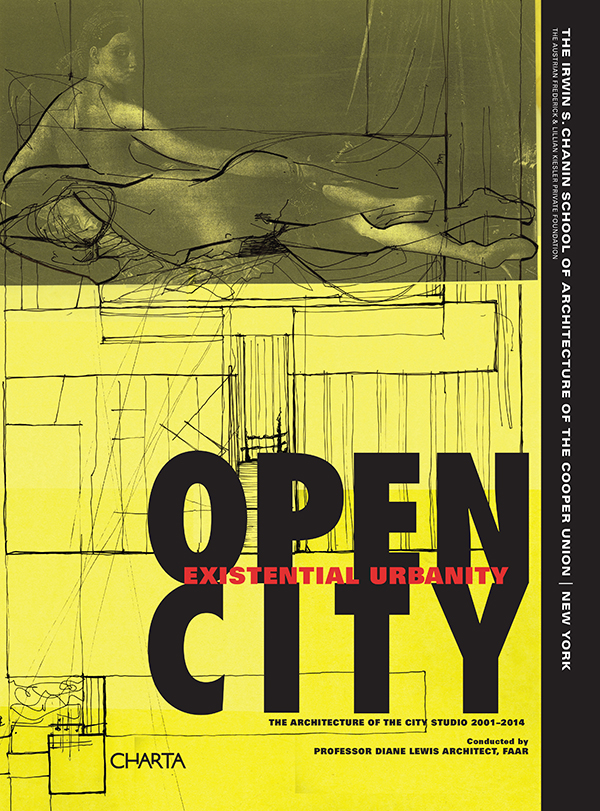
OPEN CITY: EXISTENTIAL URBANITY
Edited and designed by professors Diane Lewis, and Daniel Meridor, with Matthew Hitscherich
Open City builds on the tradition of two earlier publications entitled Education of An Architect: A Point of View (1972) and Education of an Architect (1988), which established the internationally influential curriculum that begins with Architectonics, the structural and spatial vocabulary of architecture, and demonstrated the unique impact of that foundation on the five-year degree program at The Cooper Union. The subtitle “Existential Urbanity” reveals the underlying interest in the neo-realist concepts of the Italian Cinema and its parallels in architecture: the architectural art of cultivating the “text” of an existing place into the significance of the form and use envisioned for an open space and civic institution.
The anthology represents drawings, models, and texts for works of civic architecture. Each of the project proposals considers the architectural memory of a given site as inspiration to the design of the structural form and the humanitarian program proposed. This unique study of the city advanced at The Cooper Union presents a strong picture of a generation’s cutting-edge civic activism, poetic vision and concerns about sustainability, which are aptitudes identified with the legacy of this architecture school.
Apropos of the theoretical roots and the poetics of this approach to the city, Richard Meier, Barry Bergdoll, Curator of Architecture and Design at MoMA, and Diane Lewis contributed the introductory essays with an epilogue by Professor Anthony Vidler, Dean of the School of Architecture from 2001 to 2013. The introduction also includes essays by Peter Schubert and Francois de Menil. The illustrious and diverse roster of the team who participated in teaching this design studio with Professor Lewis whose essays introduce each studio chapter include the architects Peter Schubert, Georg Windeck, Mersiha Veledar, Roger Duffy, Calvin Tsao, Thomas Tsang, Daniel Meridor and Robert Estrin, and the historian/theorist Daniel Sherer.
Texts by diverse contributors such as writer Fran Lebowitz, and Karen Wong, Deputy Director of the New Museum, powerfully frame the overarching philosophy of the fourth-year "Architecture of the City" studio. Here, the form of the city is based in the invention and the art of siting singularly authored, poetic works of architecture within the city plan. The projects require the author/ architect to envision a simultaneously specific and ideal architectural work for the collective and for their time, which is drawn and modeled at a detailed architectural scale. These attributes present a studio discipline taught as the architectural art of the city, as opposed to planning or urban design.
NY: THE IRWIN S. CHANIN SCHOOL OF ARCHITECTURE, 2015
EDIZIONI CHARTA, MILANO
368 PAGES, 10 ¾ x 14 ½
HARDCOVER, $75.00
Purchase


THESIS 2015
Edited by Henry Barrett, Charlie Blanchard, Charles Dorrance-King, Maja Hjertén Knutson, Alexander McLean, Arta Perezic, Christopher Stewart, and Christopher Taleff.
This publication documents undergraduate Thesis work completed during the 2014-15 academic year. Steeped in creative research, the projects presented support a pixelated view of architecture not as a single cultural entity, but as a series of micro-narratives and incongruous histories.
With texts by David Turnbull, Pep Avilés, and Elizabeth O’Donnell.
NY: THE IRWIN S. CHANIN SCHOOL OF ARCHITECTURE, 2015
72 PAGES, 8 ¾ x 12 ½
SOFTCOVER, $20.00
Purchase


THESIS 2014
Edited by Eduardo Alfonso, Derrick Benson, Laura Genes, Devon Moar, and Mark Tugman.
This publication presents the Thesis work of The Irwin S. Chanin School of Architecture class of 2014. The Cooper Union established a curriculum that included architectonics and formal organization as foundations of architectural education many years ago. Thesis at The Cooper Union expands these foundational disciplinary principles to include contemporary ecological and technological perspectives, and relational thinking that investigates Architecture's role in the construction of social networks, communicational patterning, and new forms of human settlement and civic structures. Thesis is regarded as individual work, but the School's pedagogy fosters collaborative group formation as research topics become clear. Inevitable thematic similarities appear—geo-political, humanitarian, psychological, ecological, technological and artistic.
NY: THE IRWIN S. CHANIN SCHOOL OF ARCHITECTURE, 2014
72 PAGES, 8 ¾ x 12 ½
SOFTCOVER, $20.00
Purchase


ARCHITECTS DRAW
Sue Ferguson Gussow
“Drawing is thought extended through the fingertips.”
—Sue Ferguson Gussow
For almost forty years at The Cooper Union, Professor Sue Ferguson Gussow has designed and developed a pedagogy that has influenced aspiring architects of varying drawing abilities to explore the possibilities of architecture through drawing. She uses the language of freehand drawing, one of the most fundamental but overlooked speculative tools for architects, to reveal the potential within even the most inexperienced students and show them how to fully observe and perceive the world around them.
Now, for the first time, Gussow’s unique approach to teaching drawing is collected and presented in written form in Architects Draw, the inaugural volume of the Architecture Briefs series, published by Princeton Architectural Press. Architects Draw includes more than twenty exercises that explore the most unexpected subjects to train the architect’s eye, hand, and mind—bell peppers and seashells as housing; paper bags to reveal architectural planes; shoes to define volume and void; frames and windows to consider problems of measurement and scale; and trees to explore gesture and the interpenetration of form and space—and is illustrated with more than two hundred inspirational student drawings and examples from postgraduate architectural practices.
Sue Ferguson Gussow is a figurative painter who works in a wide range of drawing and painting media. A graduate of The Cooper Union, Columbia University, and Tulane University, Gussow has served on the faculties of both the School of Art and The Irwin S. Chanin School of Architecture at The Cooper Union and has taught and lectured at several universities and art institutions, among them Yale, Columbia, Bennington, New York University, Maryland Art Institute, Parsons School of Design, and the Frick Collection. Now Professor Emerita of the Irwin S. Chanin School of Architecture, she presently teaches the Advanced Drawing Seminar.
NY: PRINCETON ARCHITECTURAL PRESS, 2008
176 PAGES, 7 x 8 1/2
229 ILLUSTRATIONS
SOFTCOVER, OUT OF PRINT


ROME | BERLIN | NEW YORK
Diane Lewis, Peter Schubert, Georg Windeck
"Now prepare to make a fantastic assumption. Rome was not a human inhabitation, but also a psychic substance or creature, with a similarly rich and substantial past in which not only whatever has been in existence has never perished but also, parallel to the last phase of development, all earlier incarnations live on."
—Sigmund Freud, Civilization and its Discontents, 1927
The project is a study of the plans of the cities Rome, Berlin, and New York in order to propose a 21st-century civic institution and define its site with significance in regard to Freud's definition of the city as a psychic entity. This was the assignment to the fourth-year architecture students at the Cooper Union on September 7, 2001. Four days later the destruction of the World Trade Center occurred.
All the participants in this class witnessed the 9/11 event with their own eyes. Whether seen from the roof of the Cooper Union building or within the streets of New York, each student and faculty member proceeded to address the civic space of architecture at the scale of the city, past, present, and future, for one semester. Although there is only one project specifically proposed for the Ground Zero site, the subject as a whole can be seen as an address to the question. This study as conducted in the aftermath of this monumental urban event is motivated toward the creation of intimate civic space with inventive contemporary program. As the city is now open for redefinition, the project can be considered to address the future conscience necessary to solve the problems posed. The institutions proposed integrate an understanding of the relation between form, site, and program within a literary vision of the possibility of the city.
NY: THE IRWIN S. CHANIN SCHOOL OF ARCHITECTURE, 2002
116 PAGES, 7 x 11
SOFTCOVER, $20.00
Purchase


BODY OF PRAYER:
Shaprio, Govrin, Derrida
Edited by Kim Shkapich
I leave you with this image, of prayer in a house with windows. Here, at The Cooper Union.
—Michal Govrin
The ‘Advanced Concepts’ course has been an integral part of the education of an architect within the Irwin S. Chanin School of Architecture of the Cooper Union, researching writing, art, and sound and their relations to architecture. In 1998, the poet and professor David Shapiro invited Michal Govrin, the Israeli writer and theater director, to lecture on certain spatial concepts of the sacred. She, in turn, asked Jacques Derrida to elaborate on questions these concepts raised and their visit coincided with the English publication of Govrin’s Name, a novel voiced as a prayer that was the starting point for the meditations contained in this volume. Body of Prayer is a record of the trialogue recorded on 14 October 1998, and the reverberations between the writings, poems, and fragments of novels written by Shapiro, Govrin and Derrida and an almost silent host, the Cooper Union School of Architecture’s late dean, John Hejduk.
Designed by Kim Shkapich
NY: THE IRWIN S. CHANIN SCHOOL OF ARCHITECTURE, 2001
104 PAGES, 7 x 10
SOFTCOVER, $15.00
Purchase

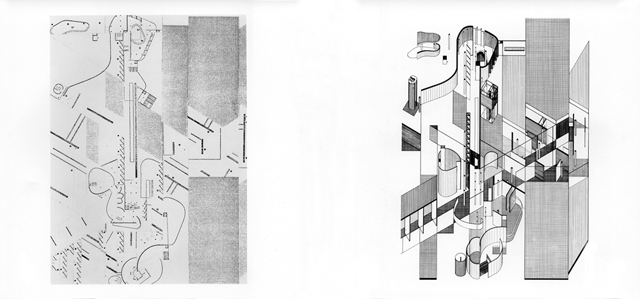
EDUCATION OF AN ARCHITECT:
A Point of View
John Hejduk and Roger Canon
Thirty years later, the Cooper experience in architectural education has demonstrated that in order to deal with the issues enumerated by the critics, in order for the work to be truly of this, our modern world, it was crucial not to abandon the discipline of architecture and substitute it for either planning and engineering, or for sociology, psychology, or anthropology, or to engage in nostalgic or populist evasions. It is a tribute to the original program of the school that such popular and often legitimate concerns never weakened the fundamental faith in the possibilities of an authentic architecture for a modern humanity, simultaneously imaginative and ethical.
—Alberto Pérez-Gómez
On November 13, 1971, the exhibition Education of an Architect: A Point of View—featuring the work of Cooper Union students under the direction of the chairman of the Department of Architecture, John Hejduk, and the dean George Sadek—opened at the Museum of Modern Art in New York. The installation of models, drawings, and photographs along with faculty and student statements, documented work from 1964 to 1971.
To accompany the exhibition, The Cooper Union published an extremely influential limited edition book—long since out of print—of 54 projects by some 60 students showing their in depth explorations of problems based on the visual discoveries of cubism and neo-plasticism as they related to architectural space and thought.
This new volume is a smaller-format reprint that includes all material from the original book—exceptional color and black-and-white drawings and model photographs—and the original introduction by Ulrich Franzen, along with two new texts, a reintroduction by architectural historian and educator Alberto Pérez-Gómez, and an essay by Kim Shkapich, director of the Architecture Archive at The Cooper Union. The reprint charts the foundations of the pedagogical inventions and methodology that a spirited and independent faculty, under the aegis of John Hejduk, brought into what has been called "the best school of architecture in the world."
Reconstructed (with additions) by Kim Shkapich based on the original design by Roger Canon.
NY: THE MONACELLI PRESS, 1999
376 PAGES, 9 3/4 x 9
340 ILLUSTRATIONS, 20 IN COLOR
SOFTCOVER, OUT OF PRINT


EDUCATION OF AN ARCHITECT
Volume 2
Edited by John Hejduk, Elizabeth Diller, Diane Lewis, and Kim Shkapich
[This book] is a tour de force and, as such, is too much to absorb in any way but repeated visits, tours, comparisons, and readings. It has the capability of inspiring and reinspiring...mobile and accessible, it is a vehicle for ideas and a container of dreams.—Dennis L. Dollens
Demonstrating the transformation and evolution of the student works of the school from 1972 to 1985, and, as well, recording their stability, this second book documents the pedagogical intensity with respect to the study of architectural form-making. It is an extraordinary display of talent, invention, and technical virtuosity.
The first part of this volume chronologically covers the first four years of the design studio: including the Ledoux exercise, the Cartesian House, the Beam and Balance projects; the Utilitarian Object; Analysis; and the urbanism investigations of the fourth year studios.
The thesis year is organized by topic: Instruments, Orders and Projections, The City, The Institution, Outskirts, The House, Bridges, Topographies, and Texts, each punctuated by faculty essays presented as tangential thoughts.
Forewords by John Jay Iselin, Bill N. Lacy and Alan C. Green. Preface by John Hejduk, Introduction by Diane Lewis and Elizabeth Diller. Designed by Kim Shkapich.
NY: CO-PUBLISHED WITH RIZZOLI INTERNATIONAL PUBLICATIONS, INC., 1988
352 PAGES, 9 x 12
829 ILLUSTRATIONS, 129 IN COLOR
HARDCOVER & SOFTCOVER, OUT OF PRINT

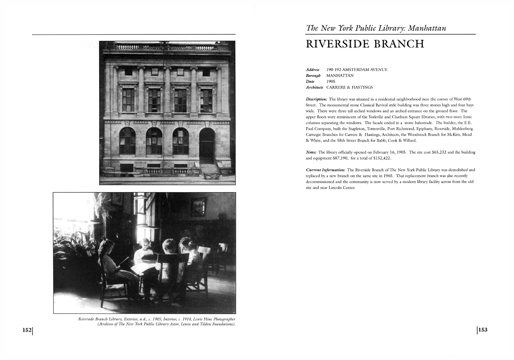
THE ARCHITECTURE OF LITERACY:
The Carnegie Libraries of New York City
Mary B. Dierickx. Photographs by Lisa Clifford.
The branch libraries provided amenities sadly lacking in the neighborhoods in which they were located. They offered books and periodicals in more than one language, a clean and well-lighted place for reading, programs supporting reading for adults and children, educational lectures, theater, and an educated and available staff of librarians for multi-lingual programming from their inception.
—Mary B. Dierickx.
Andrew Carnegie donated five and a quarter million dollars for the construction of sixty-seven branch libraries in the New York City Library System that were built between 1901 and 1929. These libraries were conceived as a collection, with similar plans, materials, and style, and were designed by the finest architects in the U.S. and New York: McKim, Mead & White; Carrere & Hastings; James Lord Brown; Babb, Cook, & Willard; and Lord & Hewlett.
Fifty-four of these libraries are still used today, comprising over a quarter of the New York Public Library system. This publication is a historical, cultural and architectural overview of the New York City Carnegie Libraries, with photographic documentation of the extant libraries and extensive bibliographic information on Carnegie libraries.
Forewords by Rudolph W. Guiliani, John Jay Iselin, and Kenneth B. Miller. With an Introduction and overview by Mary B. Dierickx, a Catalogue of the Original New York Carnegie Libraries and an Inventory of the New York Carnegie Libraries.
NY: THE IRWIN S. CHANIN SCHOOL OF ARCHITECTURE & THE NEW YORK CITY DEPARTMENT OF GENERAL SERVICES, 1996
220 PAGES, 8 1/2 x 11
167 ILLUSTRATIONS
SOFTCOVER, $25.00
Purchase

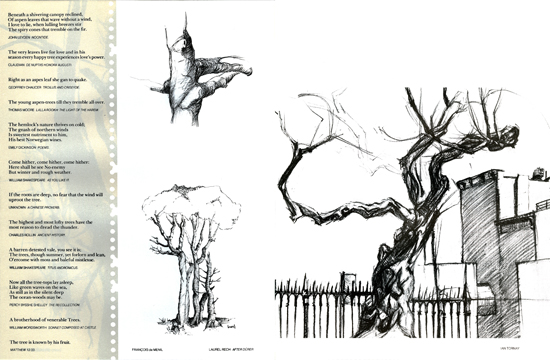
TREE
Edited by Sue Ferguson Gussow
Trees celebrate life and death. Their branches flare upward in the sky attempting to offer perches to the angels and trees root down into the earth encompassing the remains of the long dead. Man cuts trees to produce his own casket. The sap of some trees gives forth a sweetness to the lips. To draw them is to taste them.
—John Hejduk
The drawings in this volume are the outgrowth of the first year freehand drawing class in the School of Architecture. Professor Gussow juxtaposes these studies with citations from literature and poetry, creating a visually engaging book which is a visual testament to the sesnuousness of the graphite line. Published to celebrate the 125th anniversary of The Cooper Union.
Produced by The Cooper Union Center for Design & Typography, George Sadek, Director. Designed by Stuart Hicks.
NY: THE IRWIN S. CHANIN SCHOOL OF ARCHITECTURE, 1985
36 PAGES, 8 1/2 x 11
35 ILLUSTRATIONS
SOFTCOVER, $7.00
Purchase


TRENTON INDUSTRIAL CORRIDOR STUDY
An old building is a piece of history. It can teach us about our past: how things were made, and what was considered important, the "look" and the "feel" of the times.
—Frank Brill
Documenting a design studio project conducted by the faculty Diana Agrest, John P. Clarke, Sean Sculley, Richard Stein, Fred Travisano, and Michael Wurmfeld. Fourth-year Cooper Union students were challenged to draw on Trenton’s past in designing new uses for six old industrial sites along the canal corridor in Chambersburg.
The study shows that buildings constructed to meet the needs of a bygone era of industrial development can be adapted for new, modern roles. Black and white photographs of the site are accompanied by exquisite ink drawings of the solutions.
Funded by the National Endowment of the Arts. Introduction by John Hejduk.
Text by Frank Brill. Designed by George and Co.
NY: THE COOPER UNION FOR THE ADVANCEMENT OF SCIENCE & ART, 1979
28 PAGES, 11 x 8 1/2
46 ILLUSTRATIONS, 8 IN COLOR
SOFTCOVER, SPIRALBOUND, $7.00
Purchase


